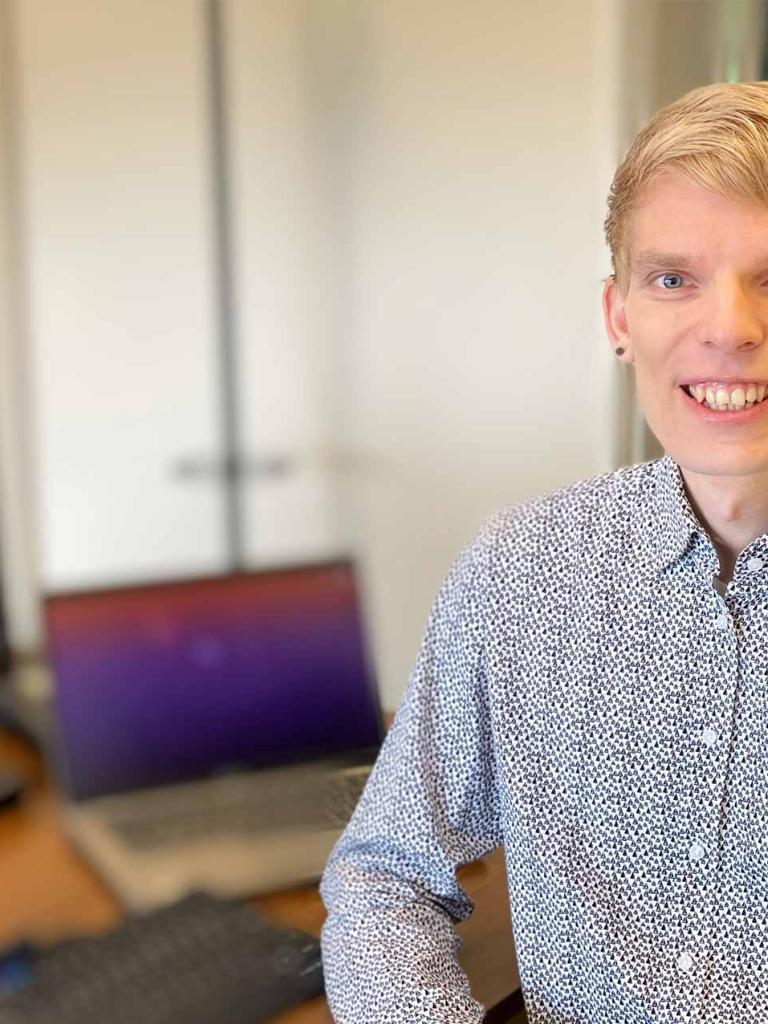
The storm seeker
Dr. Felix Erdmann aims to use data from EUMETSAT's Meteosat Third Generation Lightning Imager to improve forecasting of severe thunderstorms


Meet EUMETSAT’s Research Fellows: Dr. Felix Erdmann explains how EUMETSAT’s Meteosat Third Generation Lightning Imager will drive advances in weather prediction and lightning science.
20 June 2023
23 September 2021
As a child, EUMETSAT Research Fellow Dr. Felix Erdmann recalls sitting for hours gazing at thunderstorms, mesmerised by their beauty, power, and unpredictability. This enchantment with the extreme ultimately inspired him to pursue a career as a lightning scientist, where his postdoctoral research at the Royal Meteorological Institute of Belgium (RMI), a federal scientific institute based in Brussels, enables him to tackle questions he has long dreamed of answering.
“Thunderstorms rank as the most destructive weather-related disaster in Europe, and despite advances in forecasting it’s still very difficult to predict them,” says Erdmann, whose fellowship is focused on developing an automated severe weather warning tool that makes use of forthcoming data from EUMETSAT’s Meteosat Third Generation (MTG-I) satellite with a Lightning Imager (LI) and Flexible Combined Imager (FCI) that will be launched at the end of 2022.
“There’s no thunder without lightning, and we can use lightning observations to track thunderstorms and identify areas of deep convection – highly organised updrafts that twist, tilt, and create menacing-looking cumulonimbus clouds. Convection currents can, under certain circumstances, result in very severe storms lasting several hours, and my work aims to understand correlations between the evolution of these cells and lightning patterns.”
Detecting spikes in lightning flashes
Of particular interest to Erdmann are abrupt increases in lightning flash rates. These tell-tale signs of thunderstorm intensification, known as lightning jumps, manifest in the minutes leading up to severe weather events. They are valuable indictors, since their presence could mean that an ordinary thunderstorm is about to turn into something more sinister.
“Previous studies have shown correlations between lightning jumps as precursors to severe weather on the ground, with lead times as little as 15 to 30 minutes,” explains Erdmann. “By observing these initial surges in lightning activity, I want to help improve nowcasting, or very short range weather forecasts. Lightning jumps do not definitively mean there will be a severe weather event, but there is a link and including them in algorithms and tools will give us a better chance of accurately forecasting severe thunderstorms.”
The first part of Erdmann’s fellowship work involves matching severe weather reports from the US Storm Prediction Centre to lightning data collected by the National Oceanic and Atmospheric Administration (NOAA)’s Geostationary Operational Environmental Satellites (GOES) 16 and 17 – currently among the few next-generation weather satellites featuring lightning imagers in geostationary orbits.
“I’m using EUMETSAT’s nowcasting software (SAF-NWC) and exploring how we can integrate lightning data from space in weather models to improve nowcasting,” Erdmann explains. “The operational lightning observations from geostationary orbit give us a new perspective. I want to get a better understanding of how many severe weather events are preluded by lightning jumps, and develop algorithms that can automatically detect abrupt increases in lightning activity from satellite data. At the moment we are working with data covering the US, but as soon as MTG-I is up and running we will be able to use this for Europe as well.”
The multitude of methods used by researchers to monitor lightning activity has distinct advantages and disadvantages for understanding lightning flash rates. Lightning mapping arrays, for instance, use networks of ground-based antennas, GPS receivers, and processing systems, to collect high-frequency radio signals produced by lightning activity. They can provide comprehensive coverage of the two main types of lightning – those that flash within clouds and those that strike the ground –, but they are typically limited in range to a region with a diameter of a few 100 kilometres or less.
But what lightning scientists have been missing is space coverage of flash rates for the whole of Europe, seven days a week, 365 days a year. That is where the MTG-I Lightning Imager will come in, set to start delivering continuous lightning observations over Europe, Africa, and even parts of the Atlantic Ocean and South America (see map) from the end of 2022. Combined with existing GOES Geostationary Lightning Mapper and the Fenyun Lightning Mapping Imager, geostationary lightning imagers will provide coverage of the entire globe.
“This is the first time lightning sensors have been put on geostationary satellites able to provide continuous observations of lightning activity across Europe,” says Erdmann. "These are optical sensors and provide data from all types of lightning across a wide geographical area – including remote mountain and marine areas that are particularly difficult to monitor from the ground. We will be able to use this data to understand and track current thunderstorms, wherever they are on the continent, and then weather services will be able to use that information to make better predictions about their course."
Better forecasts
Data provided by the new MTG-I Lightning Imager will also boost meteorologists' ability to forecast other weather phenomena due to the power of data assimilation, Erdmann explains. “Understanding lightning observations in detail is also of great value on a larger scale, for instance in providing data for numerical weather predictions that make use of mathematical models of the atmosphere to forecast the weather based on current conditions: lightning observations indicate the locations of existing thunderstorms.
“Forecasts are essentially the best fit between our physical knowledge of the atmosphere and its snapshot through the data we collect. The more we know about current conditions such as temperature, pressure, or wind speed, the better the predictions,” he says. “Numerical models are limited by the available computer capacities. With high power computers, our numerical models can resolve physical processes in more detail. For example, data collected from this remarkable new lightning imager means we will now be able to integrate specific lightning point information. The more types of observation we have, the better data assimilation works. This means we will be able to improve our models not only for thunderstorms, but a heap of other aspects such as improving wind, hail, or even tornado forecasts.”
Laying the foundations for making best use of these new data presents both the biggest challenges and greatest opportunities of his fellowship, Erdmann says. “We cannot just use the same algorithms we have developed for monitoring lightning from ground-based weather stations – we need to build, develop, and fine-tune our methods,” he explains.
“My EUMETSAT fellowship gives me a lot of freedom to develop ideas to tackle these problems. The best case outcome from my project will be that we will be able to use the EUMETSAT nowcasting software to develop a product that can provide better lead times for potential severe weather warnings, and implement this here in Belgium and across Europe.
“Meteorologists are very good at forecasting thunderstorms in a particular region, but when it comes to very localised predictions it remains very challenging," Erdmann adds. "It’s like when you are making popcorn on a stove: you know the corn is going to start popping, but it's almost impossible to say which corn will pop first. Similarly, if there are atmospheric conditions favourable to thunderstorms, we can predict them, but it's extremely difficult to say which bubble of air will rise first to create the first thunderstorm. I'm looking forward to finally having these real time lightning data over Europe, which will provide us with an additional tool for forecasting extreme weather.
“EUMETSAT is playing a crucial role in bringing together international experts to do this. My fellowship is enabling me to develop new skills, make a wide range of connections, and explore ideas for collaborative projects in the future. With the launch of the new generation of satellites it’s a very exciting and important time for the field. The recent flooding in Germany, Belgium, and the Netherlands served as a reminder that weather events can quickly become highly dangerous. But, for many cases of severe weather, if we could buy just 15 minutes of time it could make all the difference, and that's my main motivation for doing this work.”
EUMETSAT Research Fellowships
In close partnership with its Member States, EUMETSAT funds a limited number of research fellowships to support young scientists in developing new uses and applications of satellite data. Through this series of articles, we showcase some of the fascinating projects Research Fellows work on, which include assimilation and analysis of satellite data to support weather prediction models; the use of satellite data for climate applications; and the development of new products and applications in areas spanning oceanography, hydrology, and atmospheric composition. EUMETSAT Research Fellows are hosted by institutions within EUMETSAT Member States, who also coordinate applications to the programme in response to an annual call for proposals.
Credit
Photograph of Dr. Felix Erdmann taken by Patrick Wylleman.